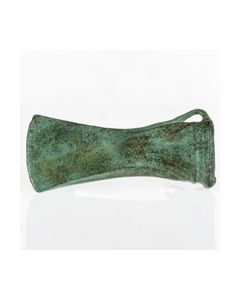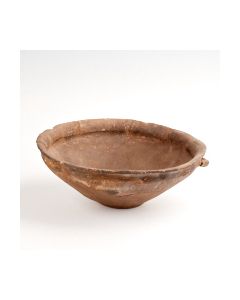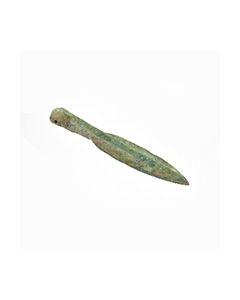Search results for: 'Rom'
-
 Hoard from the Late Bronze Age
Hoard from the Late Bronze AgeComplete surviving hoard consisting of one bronze bowl, two belts and twelve bracelets. Urnfield culture HaB1. The amazingly well preserved group is excessively rare on the art market as well as in museum collections.
€12,500 Socketed axe head from Southern Germany
Socketed axe head from Southern GermanyA typical bronze tool of the late Urnfield culture or early Hallstatt culture. It was found near Regensburg in Southern Germany by a voluntary archaeologist.
Price: on request Small storage vessel from Early Bronze Age
Small storage vessel from Early Bronze AgeThe elegant vessel could be stringed and suspended to protect its content from animals. From Early Bronze Age Europe.
Price: on request Large knife from early Bronze Age Europe
Large knife from early Bronze Age EuropeBeeindruckendes Bronzemesser mit elegant geschwungener Klinge. Besonders hervorzuheben ist der gut erhaltene Teller und Griffdorn. Hervorragende Erhaltung des Metalls.
Price: on request Spear end cap from Bronze Age Europe
Spear end cap from Bronze Age EuropeSeltenes Exemplar eines Speerfußes aus der europäischen Bronzezeit. Das Material ist in hervorragender Erhaltung und zeugt von der damiligen Ausrüstung eines Kriegers.
Price: on request Bronze socketed axe head from large collection
Bronze socketed axe head from large collectionSehr schönes Exemplar eines Bronzebeils vom Typ der sogenannten Tüllenbeile. Es stammt aus einer gut geführten Sammlung, die einen breiten Querschnitt europäischer Tüllenbeile abbildet.
Price: on request Clay rattle shaped as a bird from the Lusatian culture
Clay rattle shaped as a bird from the Lusatian cultureRassel in Form eines Hauses. Aus dem Übergang der Späten Bronzezeit zur Frühen Eisenzeit Nordmittel-Europas. 1300 bis 500 v. Chr.
Price: on request Small bowl from the Lusatian culture
Small bowl from the Lusatian cultureKleines Schälchen aus grober Keramik. Möglicherweise Votivgabe oder Grabbeigabe für Kinder.
Price: on request Small flat bowl from the Lusatian culture
Small flat bowl from the Lusatian cultureKleines, flaches Trinkschälchen mit Henkel. Möglicherweise Votivgabe oder Grabbeigabe für Kinder. Museale Erhaltung, keine Schäden oder Risse.
Price: on request Small socketed axe head from the late Bronze Age
Small socketed axe head from the late Bronze AgeBronzezeitlicher Beilkopf mit vierkantigem Querschnitt. Schön erkennbarer Grat von der Herstellung in einer Gussform. Ringöse an der Seite. Späte Bronzezeit.
Price: on request Museum quality grindstone from the late Neolithic
Museum quality grindstone from the late NeolithicHochinteressantes und äußerst seltenes Werkzeug aus der jüngeren Steinzeit oder angehenden Bronzezeit. Eindrucksvolle Nutzungsspuren vom Schleifen von Klingen aus Stein oder Bronze.
Price: on request Double spiral pendant from Bronze Age Central Europe
Double spiral pendant from Bronze Age Central EuropeTypical decorative element of a wealthy woman's dress in the European Middle Bronze Age. Several of these spiral pendants were worn around the waist. Similar to belt mounts or charms. 1500 to 1200 BC.
Price: on request Double spiral pendant from Bronze Age Central Europe
Double spiral pendant from Bronze Age Central EuropeTypical decorative element of a wealthy woman's dress in the European Middle Bronze Age. Several of these spiral pendants were worn around the waist. Similar to belt mounts or charms. 1500 to 1200 BC.
Price: on request Juglet from the Urnfield period
Juglet from the Urnfield periodSmall juglet dating to the transition period between Bronze Age and Iron Age in Central Europe. 1200 to 800 BC. Found in an urnfield in Lower Austria.
Price: on request Big bowl from the Urnfield period
Big bowl from the Urnfield periodCeramic vessel dating to the transition period between Bronze Age and Iron Age in Central Europe. 1200 to 800 BC. Found in an urnfield in Lower Austria.
Price: on request Spear head from famous Guttmann collection
Spear head from famous Guttmann collectionMassive, perfectly preserved piece, beautiful patina. Inventory number "AG 167c" from famous Axel Guttmann collection in shaft.
Price: on request Spear head from famous Guttmann collection
Spear head from famous Guttmann collectionMassive, perfectly preserved piece, beautiful patina. Inventory number "AG 167c" from famous Axel Guttmann collection in shaft.
Price: on request Spear head from famous Guttmann collection
Spear head from famous Guttmann collectionMassive, perfectly preserved piece, beautiful patina. Inventory number "AG 167c" from famous Axel Guttmann collection in shaft.
Price: on request Spear head from famous Guttmann collection
Spear head from famous Guttmann collectionMassive, perfectly preserved piece, beautiful patina. Inventory number "AG 167c" from famous Axel Guttmann collection in shaft.
Price: on request Sword of the Urnfield culture from a museum collection
Sword of the Urnfield culture from a museum collectionWonderfully preserved bronze weapon from the time around 1000 BC. It was made in Central Europe by the Urnfield culture and formed part of a museum collection for almost 70 years.
€13,500 Dagger from the Northern European Bronze Age
Dagger from the Northern European Bronze AgeThe double edged blade is from a dagger or short sword of the 2nd Millennium BC. With a nicely cleaned surface with a slight patina.
€2,600 Sword from the European Bronze Age
Sword from the European Bronze AgeWonderfully preserved bronze weapon from the Late Bronze Age around 1200 BC. Of the Reutlingen type, made in the region of today's Germany or surrounding countries.
Price: on request Neolithic flint dagger from Denmark
Neolithic flint dagger from DenmarkDouble-edged blade and flat shaft made of beautiful flintstone. A status symbol from the transitional period between Late Neolithic and Early Bronze Age.
€480 Neolithic dagger blade from Denmark
Neolithic dagger blade from DenmarkDouble-edged, pointed blade made of beautiful flint. The blade was for a dagger, the typical status symbol from the transitional period between Late Neolithic and Early Bronze Age.
€470

